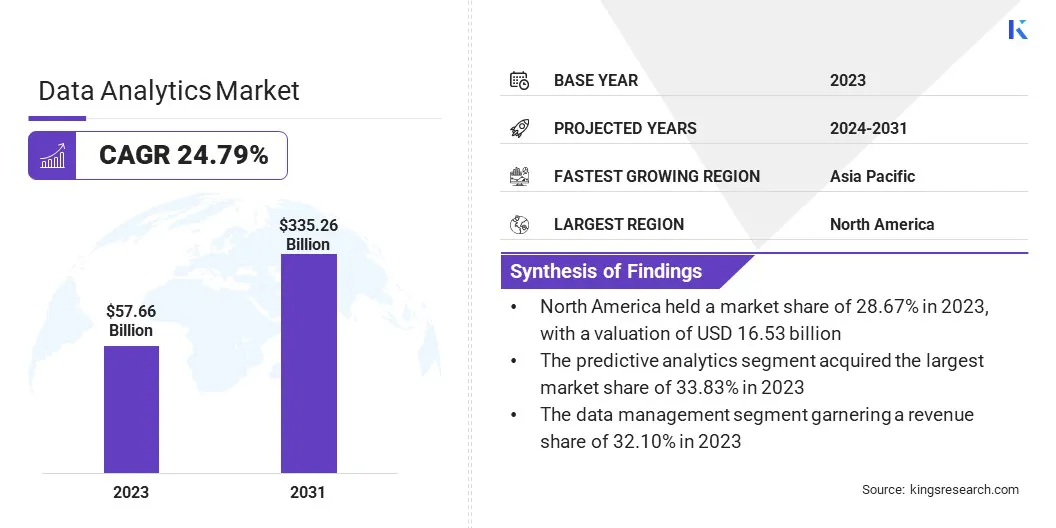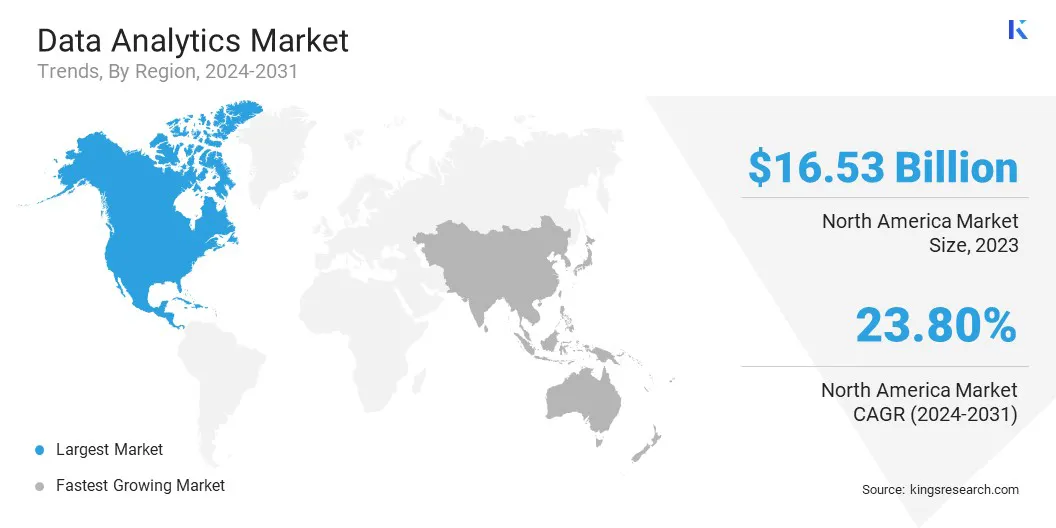Data Analytics Market Size
The global Data Analytics Market size was valued at USD 57.66 billion in 2023 and is projected to reach USD 335.26 billion by 2031, growing at a CAGR of 24.79% from 2024 to 2031. In the scope of work, the report includes solutions offered by companies such as IBM, Microsoft, Oracle, SAP SE, Amazon Web Services, Tableau Software, SiSense Inc,, Zoho Corporation, Data Sciences, Datameer Inc and Others.
The data analytics market is experiencing significant growth due to the increasing demand for data-driven decision-making and insights across industries. This trend is fueled by the growing volume of data generated by businesses and the need to extract meaningful information from it.
Furthermore, advancements in technology, such as machine learning and artificial intelligence, have greatly enhanced the capabilities of data analytics tools. These tools can now process and analyze vast amounts of data in real-time, allowing businesses to make faster and more accurate decisions.
Additionally, the cost of implementing data analytics solutions has decreased over time, making them more accessible to small- and medium-sized enterprises. With the increasing recognition of the value of data-driven insights, the data analytics market is expected to continue its growth trajectory in the coming years.

Analyst’s Review
In recent times, the data analytics sector has witnessed notable expansion, driven by a significant surge in the need for cutting-edge analytics software and solutions. A prominent development in this industry is the rising integration of artificial intelligence and machine learning algorithms, enabling enterprises to extract valuable insights from their data.
Additionally, there is a growing preference among consumers for self-service analytics platforms, which enable them to access and analyze data on their own, without the need for IT assistance. This shift towards self-service analytics reflects a desire for greater flexibility and agility in decision-making processes.
Furthermore, there is an increase in the need for real-time data analysis. This demand arises from the mounting emphasis of businesses on making prompt and well-informed decisions by utilizing the most current and up-to-date information available. This trend is primarily influenced by the growing significance of real-time insights in sectors like finance, e-commerce, and healthcare.
Real-time analytics enables businesses to respond quickly to changing market conditions, identify emerging trends, and optimize their operations in real-time. As a result, the increasing demand for real-time analytics in the business world has led organizations to invest in advanced analytic tools and technologies.
These tools and technologies enable real-time data processing and analysis, which are crucial in today's fast-paced and data-driven environment, thereby boosting the growth of the market.
Market Definition
Data analytics is the meticulous process of scrutinizing unprocessed data to reveal trends, deduce conclusions, and facilitate well-informed decision-making. Employing a variety of techniques and tools, data analytics enables the examination of extensive data sets to extract valuable insights. In the current digital era characterized by rapid technological advancements, the significance of data analytics has escalated significantly.
Organizations spanning various sectors are capitalizing on data analytics to acquire a competitive advantage and propel their growth. By analyzing specific patterns and consumer preferences, companies can tailor their offerings to address the ever-changing needs of their target audience. This leads to increased customer satisfaction and enhances the likelihood of securing repeat business.
Furthermore, the application of data analysis allows organizations to identify potential opportunities for improving their internal operations. By examining data pertaining to production processes, supply chain management, and customer feedback, companies can identify obstacles and inefficiencies, resulting in cost reductions and enhanced efficiency.
Additionally, data analytics helps businesses make informed decisions based on data-driven insights. Whether it's developing marketing strategies, launching new products, or entering new markets, data analytics provides valuable information that helps reduce risks and increase the chances of success. Thus, data analytics has emerged as a transformative tool for businesses, empowering them to maintain a competitive edge in the market and foster sustainable growth in the long run.
Data Analytics Market Dynamics
The data analytics market has experienced remarkable growth due to the significant impact of artificial intelligence and advancements in machine learning technologies. These technological advancements have revolutionized the collection, analysis, and utilization of data, empowering businesses to extract valuable insights and make informed decisions based on reliable data.
The surging demand for AI and ML technologies in various industries, such as healthcare, finance, and retail, has fueled the expansion of the data analytics market. Furthermore, the capacity of artificial intelligence (AI) and machine learning (ML) algorithms to swiftly handle vast amounts of data has resulted in enhanced effectiveness and precision in data analysis, which is fostering the product outlook.
Additionally, industry growth can be attributed to the influence of consumer preferences, since individuals now seek personalized experiences and suggestions that can only be realized through advanced data analytics methods.
In the realm of technology, the combination of artificial intelligence (AI), machine learning (ML), and data analytics is driving significant transformations across various industries. This convergence has resulted in a multitude of benefits, including enhanced decision-making capabilities and the ability to uncover valuable insights and patterns. These advancements are empowering businesses to improve strategic planning, optimize costs, and boost revenue generation.
In the digital era, data analytics has become an indispensable tool as technology continues to evolve and data becomes increasingly accessible, the data analytics market is projected to experience exponential growth in the foreseeable future.
However, data privacy and security concerns are restraining the growth of the data analytics market due to the increasing number of high-profile data breaches and unauthorized access to personal information.
As a result of increasing consumer wariness and their soaring requirement for data autonomy, there has been a surge in the introduction of more stringent regulations such as the European Union's General Data Protection Regulation(GDPR). These regulations necessitate that organizations adopt comprehensive data protection protocols, which can prove to be both financially burdensome and time-intensive, consequently hindering the expansion of the data analytics industry.
Segmentation Analysis
The global data analytics market is segmented based on type, solution, application, and geography.
By Type
Based on type, the market is bifurcated into prescriptive analytics, predictive analytics, customer analytics, descriptive analytics, and others. The predictive analytics segment acquired the largest market share of 33.83% in 2023. This dominance is attributed to the growing accessibility of large datasets, which has led organizations to recognize the significance of utilizing this extensive pool of information to obtain valuable insights and make well-informed choices.
Moreover, utilizing predictive analytics empowers organizations to examine past data, recognize patterns, and foresee forthcoming results, providing them with a distinctive advantage in the industry. Additionally, there has been a shift in consumer inclinations towards individualized experiences and targeted advertising.
By leveraging predictive analytics, businesses can gain a deeper understanding of their clientele, anticipate their requirements, and offer customized products or services, ultimately augmenting customer contentment and fostering loyalty.
By Solution
Based on solution, the market is bifurcated into security intelligence, data management, data monitoring, and data mining. The data management segment has emerged as a dominant segment in the ammonia market, garnering a revenue share of 32.10% in 2023 due to its ability to effectively handle and analyze massive amounts of data.
This segment leverages cutting-edge technologies such as machine learning and artificial intelligence to provide accurate and valuable insights to businesses. Furthermore, there is an escalating need for solutions that can effectively handle data as organizations value data-driven decision making. This surge is also driven by the need for tailored experiences by customers and the necessity for a competitive edge in the ever-changing digital environment.
Amazon and Netflix are prominent examples of companies that have achieved extraordinary success by utilizing data management strategies to provide personalized recommendations. This approach has led to increased customer satisfaction and improved profitability.
By Application
Based on application, the market is bifurcated into supply chain management, enterprise resource planning, database management, human resource management, and others. The database management segment has emerged as a dominant segment in the data analytics market with a share of 30.87% in 2023, This is due to the increasing trend among businesses to collect and analyze large amounts of data to gain valuable insights and make well-informed decisions.
Consequently, there is a rising demand for strong and efficient database management systems that can effectively store, organize, and process massive volumes of data. Furthermore, the exponential growth of data from sources like social media, IoT devices, and online transactions has further intensified the requirement for advanced database management solutions.
Data Analytics Market Regional Analysis
Based on region, the global data analytics market is classified into North America, Europe, Asia Pacific, MEA, and Latin America.

The North America Data Analytics Market share stood around 28.67% in 2023 in the global market, with a valuation of USD 16.53 billion, and is witnessing a clear trend towards digital transformation in industries across the region, which has led to an increased demand for data analytics solutions.
Corporations are increasingly recognizing the importance of leveraging data to gain valuable insights and make informed business decisions. Furthermore, the data analytics industry is growing in North America due to its strong technological infrastructure and skilled workforce.
Moreover, shifting consumer preferences toward availing accurate data and precise marketing strategies emphasizes the importance of utilizing sophisticated data analytics tools in the region. Thus, North American companies are widely recognized as leaders in the development and implementation of these solutions, granting them a distinct competitive advantage in the global market.
Asia-Pacific is projected to register for the highest CAGR over the forecast period in the data analytics market, this projection is primarily driven by the significant increase in internet usage and the widespread adoption of smartphones in the region, leading to a substantial growth in data production. This abundance of data offers companies a valuable opportunity to extract meaningful information and utilize it to make informed decisions based on data analysis.
Furthermore, the increasing number of wealthy individuals in the region and their higher income availability has resulted in an increased need for customized goods and services.
As a result, companies have turned to data analytics to gain insights into consumer preferences and tailor their offerings accordingly. These circumstances, along with the region's emphasis on technological progress and digitalization, have provided a favorable setting for the rapid expansion of the data analytics industry in the Asia-Pacific region.
Competitive Landscape
The global data analytics market study will provide valuable insights with an emphasis on the fragmented nature of the industry. Prominent players are focusing on several key business strategies, such as partnerships, mergers & acquisitions, product innovations, and joint ventures to expand their product portfolio and increase their respective market shares across different regions.
Expansion & investments are the major strategic initiatives adopted by companies in this sector. Industry players are investing heavily in R&D activities, building new manufacturing facilities, and supply chain optimization.
List of Key Companies in Data Analytics Market
- IBM
- Microsoft
- Oracle
- SAP SE
- Amazon Web Services
- Tableau Software
- SiSense Inc,
- Zoho Corporation
- Data Sciences
- Datameer Inc
Key Industry Developments
- April 2021 (Product launch): Tredence Inc., a leading AI analytics service company, launched ML Works, a state of art machine learning platform for engineers, data scientists, and analysts.
The Global Data Analytics Market is Segmented as:
By Type
- Prescriptive Analytics
- Predictive Analytics
- Customer Analytics
- Descriptive Analytics
- Others
By Solution
- Security Intelligence
- Data Management
- Data Monitoring
- Data Mining
By Application
- Supply Chain Management
- Enterprise Resource Planning
- Database Management
- Human Resource Management
- Others
By Region
- North America
- Europe
- France
- UK
- Spain
- Germany
- Italy
- Russia
- Rest of Europe
- Asia Pacific
- China
- Japan
- India
- South Korea
- Rest of Asia Pacific
- Middle East & Africa
- GCC
- North Africa
- South Africa
- Rest of Middle East & Africa
- Latin America
- Brazil
- Argentina
- Rest of Latin America


